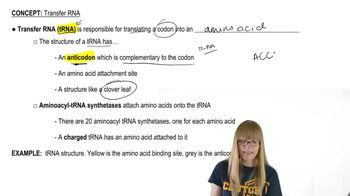A portion of a DNA template strand has the base sequence 5′-...ACGCGATGCGTGATGTATAGAGCT...-3′
Which is the third amino acid added to the polypeptide chain?
Describe three features of tRNA molecules that lead to their correct charging by tRNA synthetase enzymes.
 Verified step by step guidance
Verified step by step guidance
Verified video answer for a similar problem:
Key Concepts
tRNA Structure

Aminoacyl-tRNA Synthetase
Recognition and Specificity

A portion of a DNA template strand has the base sequence 5′-...ACGCGATGCGTGATGTATAGAGCT...-3′
Assume the mRNA is written in the correct reading frame. Determine the amino acid sequence encoded by this fragment. Identify the N- and C-terminal directions of the polypeptide.
What are the differences between the universal code and that found in the mitochondria of some species? Given that some changes (UGA =stop→Trp) have occurred multiple independent times in evolution, can you think of any selective advantage to the mitochondrial code?
Identify the amino acid carried by tRNAs with the following anticodon sequences.
5′-UAG-3′
Identify the amino acid carried by tRNAs with the following anticodon sequences.
5′-AAA-3′
Identify the amino acid carried by tRNAs with the following anticodon sequences.
5′-CUC-3′

